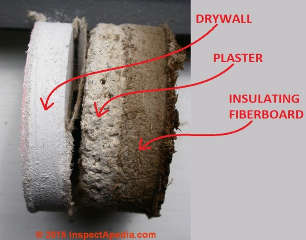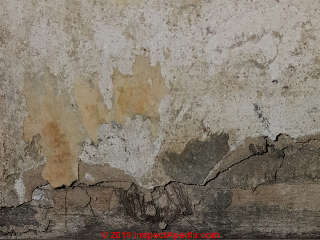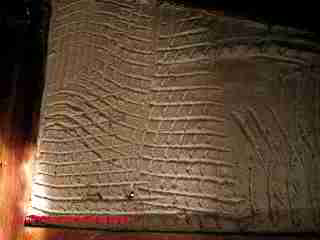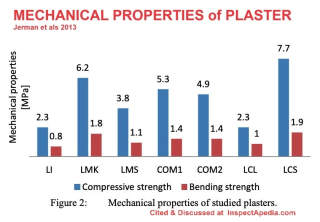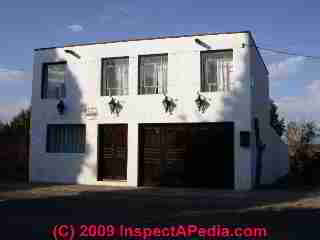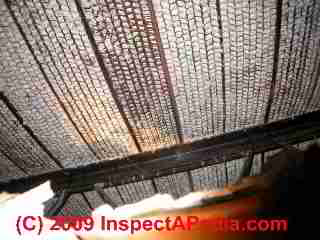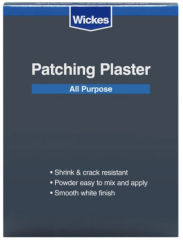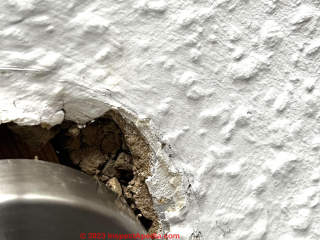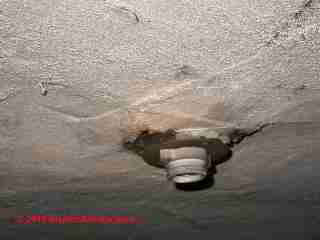 Plaster Ingredients & Properties
Plaster Ingredients & Properties
Mixes & Properties of Plaster
- POST a QUESTION or COMMENT about interior wall & ceiling plaster
Components or ingredients used in plaster walls & ceilings:
What are the ingredients in historic & modern building plaster? Do they include asbestos?
This article describes the common ingredients used in making both trowel-applied and sprayed-on plaster used in building ceilings and walls as coatings, fire-resistant sprays, ornaments, and for similar indoor as well as exterior plaster coating applications.
In this article series we describe and discuss the identification and history of older interior building surface materials such plaster, plaster board, split wood lath, sawn lath, and expanded metal lath, Beaverboard, and Drywall - materials that were used to form the (usually) non-structural surface of building interior ceilings and walls.
InspectAPedia tolerates no conflicts of interest. We have no relationship with advertisers, products, or services discussed at this website.
- Daniel Friedman, Publisher/Editor/Author - See WHO ARE WE?
Ingredients in Plaster Used in Buildings
 Reader Question: asbestos in horsehair-plaster?
Reader Question: asbestos in horsehair-plaster?
2015/12/08 PHP asked [by private email] [Click to enlarge any image]
I appreciate your website since I have recently purchased a home built in 1870 that has many additions and upgrades. There are a few areas of concern. One is some white ceiling tiles in the closet. Not sure when addition was done but it has paneling for walls.
They are roughly 21x16. White with brown cardboard looking substance in the cracks. The other thing that scared me was the basement. I have attached a picture of the wall containing long fibers.
Thanks again. - Anon [by private email 2015/12/07]
Update: The homeowner had a sample of this plaster tested for asbestos and reported:
Just to update you. The hairy plaster came back negative for asbestos.
The insulation around the pipe [referring to a white sealant paste around the connection of a flue vent connector to a masonry chimney] was 40% Chrysotile. - Anon [by private email] 2015/12/22
Reply:
Yes some plaster contains asbestos, but certainly not all plaster used asbestos in its mix. Details are
Two coat and three-coat plaster on lath systems are detailed
at PLASTER TYPES & METHODS in BUILDINGS
Let me see some photos of the ceiling you are discussing;
Your basement photo looks like old plaster that contained horse hair. Some added sharp photos might help.
Watch out: asbestos was used in some (not all) plaster formulations in both fiber form (as reinforcement) and fine particulate form (as a filler or to improve workability) (Croce 1954) in both hand-troweled plaster and later (perhaps in the U.S. beginning in the 1940's and confirmed by patents in the 1970's) in fire-retardant plaster based spray coatings.
Lange (2002) identified chrysotile asbestos as a significant ingredient in a trowel-applied plaster coating on ceilings and walls in a school rotunda.
My research found U.S. patents describing the use of asbestos in plaster preparations from as early as 1896 (Knight, 1876 - not as a surface coating but in plaster-asbestos mixed for use in a gas regulator) which suggests asbestos addition to plaster was in common use even before that time.
Watch out also not to panic but at the same time to avoid creating a dusty mess. Some uses of asbestos may not produce measurable levels of airborne asbestos in buildings. (Burdett 1986).
My photo above illustrates layers of plaster atop fiberboard wall sheathing and a top-most layer of modern drywall at the left side of my wall cut.
Historically the common ingredients in plaster have included the materials in the following list. Keep in mind that plasterers "back in the day" may have made use of locally-available cheap materials such as mud and straw or waste animal hair, also in coastal areas coral or seashells.
Before naming the specific ingredients in plaster it's useful to understand the concept: the plasterer prepares a plastic material that can be troweled onto a ceiling or wall surface, ultimately to provide a finished surface or for fireproofing.
The mixture will require water, lime, an aggregate that provides body (sand, stone, shells), and tensile strength (hair, straw, hay, other fibers). Here are common ingredients in plaster (not all used in any given mix).
Typical Ingredients in Plaster
- Animal hair, often horsehair - photo above provided by InspectApedia.com reader C.D. who worried that the plaster might contain asbestos.
- Asbestos - see details at PLASTER ASBESTOS CONTENT
- Clay
- Lime or "quicklime"
- Gypsum
- Moss
- Mud
- Portland cement
- Sand
- Straw
The specific plaster mix prepared also varied depending on the plaster coat and whether a two coat or three-coat system was to be applied.
The brown coat or scratch coat was more coarse, put on first, and provided the base, often comprised of sand and lime and after about 1910, portland cement.
See historical details of the development of Adamant Panel Board that, at US Gypsum was re-named "Sheetrock® discussed also
The plaster base coat was very coarse and was referred to as a scratch coat or brown coat. Sometimes in attics and basements just the brown coat or scratch plaster coat was applied, which is why I was able to take the photo shown just below.
The gouges or scratches in the brown coat were made by the plasterer using a notched tool or saw-tooth-edged tool to improve the adhesion of the next coat. The first two plaster coats would each be about 3/8" thick while the final coat was quite thin, just 1/8" in thickness.
The final top coat was intended to be troweled smooth and typically would have included the highest lime or gypsum content of the two or three layers.
Before about 1900 in North America the principal plaster mix included lime, sand, horsehair and of course water. After about 1900 gypsum became the main ingredient - it's safer to work-with for one thing - in a version of plaster most-widely referred to as either "gypsum plaster" or plaster of Paris. Your plaster from the 1800's in the U.S. will be the older lime and sand and horsehair mix.
Your plaster was probably simply hand-troweled onto the stones of your basement foundation wall without any lath backing.
Spray-on plaster coatings, widely used as a fireproofing in ships and buildings were more likely to include asbestos as well as rock wool, vermiculite, and fiberglass.
Asbestos was been used in other plaster preparations too. Spray-on plaster ceiling coatings beginning much later (perhaps in the 1960's [citation needed] included styrofoam or similar beads or fragments.
Reader Follow-up:
I thought about horsehair and hay is what it felt like. New old house has me paranoid. Thank you so much. I will get some better pictures as well.
Reply:
Horsehair is quite coarse - thicker than human hair - at least mine.
The ceiling in your photos looks like a cellulose fiber product - not asbestos, though there are some cross-contamination exceptions.
Also see FIBER & HAIR IDENTIFICATION
Reader Follow-up:
And yes I looked through the tile section but couldn't find anything quite like this. And I used my brain and went down with a lighter and light the fiver, definitely hair so that is a relief! Since it is hair does that normally rule out asbestos due to the timeframe?
Reply:
Yes some plaster formulations included asbestos. We discuss this here,
at PLASTER ASBESTOS CONTENT and
in PLASTER TYPES & METHODS in BUILDINGS [where I've repeated this email conversation]
Reader Follow-up:
After reading that, seeing how this was applied, I guess I should treat it like it contains asbestos and send off for a test? I spent 2 hours dry there vacuuming the broken bits up with just a dusk mask on and a fan going out the window, probably not the best thing to do. I live in up state NY, can you recommend a good affordable place to send samples to?
Reply:
It is safest to treat the material as presumed to contain asbestos; a lab test costs about $50. and is worth doing IF there is a large area to be demolished or cleaned-up such that you'd have to hire a professional.
See ASBESTOS TESTING LAB LIST
Watch out: STOP VACUUMING unless you have a HEPA-rated vacuum as IF there is asbestos in the material you're cleaning-up you may be increasing the airborne particle level. Ultra-fine particles pass right through conventional vacuums.
Damp wipe and HEPA vacuum is best. More details about typical asbestos-containing plaster or asbestos-suspect plaster removal are given in the citations later in this article. Eye and respiratory protection is also important during demolition of plaster. OSHA's PEL [Permissible Exposure Limit] to plaster of paris dust in the workplace is 15 mg/m3 total exposure and 5 mg/m3 respiratory exposure over an 8-hour workday.
The National Institute for Occupational Safety and Health (NIOSH) has set a Recommended exposure limit (REL) of 10 mg/m3 total exposure and 5 mg/m3 respiratory exposure over an 8-hour workday. [Wikipedia 2015/12/08, https://en.wikipedia.org/wiki/Plaster]
My OPINION is that asbestos was more likely to be found in plaster formulations that were designed specifically for fire-proofing, particularly spray applications such as described in Bragg (1973). Plaster in private home use on walls and ceilings is less likely to contain asbestos but we won't know for certain in individual cases without a lab test.
Visual inspection of the plaster won't answer the asbestos question. The use of plaster as a fire-retardant covering dates (in the U.S.) from the time of the revolution and (if my memory serves) was recommended by Ben Franklin as a fire resistance improvement in homes.
Properties of Plaster / Plaster of Paris - Research
- Cameo Chemicals PLASTER of PARIS [PDF] - retrieved 2023/09/12, original source: cameochemicals.noaa.gov/chemical/25054#:~:text=PLASTER OF PARIS is non,water to form gypsum CaSO4. - Alternate chemical names: Calcium Sulfate Hemihydrate Crystacal Densite Densite (Gypsum) Dried Calcium Sulfate Dried Gypsum Fgr Gypsum Hemihydrate Hemihydrate Gypsum Ph 200 Ph 200 (Filler) Plaster Of Paris Sakura Plaster Of Paris B Grade Ta 20 Tiger Stone
- CEF, DESIRABLE PROPERTIES of [Portland Cement] PLASTER - Civil Engineering Forum, Web: civilengineeringforum.me - retrieved 2023/09/12, original source: civilengineeringforum.me/desirable-properties-plaster/
Excerpt:
Portland cement plaster must have certain properties in both the fresh and hardened state to allow proper application and long-term service. A properly mixed plaster can be either hand or machine applied.
Freshly mixed plaster should have good adhesion and cohesion characteristics and should remain workable long enough to obtain the desired surface. Hardened plaster should be weather resistant, durable, and should provide the specified appearance criteria (color and texture). - Dalchem, CHARACTERISTICS about GYPSUM PLASTER [PDF] Dalchem Moulding & Casting Supplies, 141 Herald Street, Cheltenham, 3192 Victoria, Australia, Web: dalchem.com.au Tel: 03 9553.7040 - retrieved 2023/09/12, original source: https://dalchem.com.au/how-to/characteristics-about-gypsum-plaster/
- Dylewski, Robert, and Janusz Adamczyk. "The comparison of thermal insulation types of plaster with cement plaster." Journal of cleaner production 83 (2014): 256-262.
- Eckel, Edwin Clarence. Cements, limes, and plasters: their materials, manufacture, and properties. J. Wiley & Sons, 1907.
- Hattan, Hamed Abbasi, Mortaza Madhkhan, and Afshin Marani. "Thermal and mechanical properties of building external walls plastered with cement mortar incorporating shape-stabilized phase change materials (SSPCMs)." Construction and Building Materials 270 (2021): 121385.
- Jerman, M., E. Vejmelková, M. Keppert, and R. Černý. PROPERTIES OF PLASTERS SUITABLE FOR RECONSTRUCTION OF HISTORICAL BUILDINGS [PDF] [Illustration above] Structural Studies, Repairs and Maintenance of Heritage Architecture XIII 131 (2013): 369-378. - retrieved 2023/09/12, original source: witpress.com/Secure/elibrary/papers/STR13/STR13031FU1.pdf
Abstract:
Basic physical properties, mechanical properties, hygric and thermal properties of several types of plasters which are used in the reconstruction of historical buildings in the Czech Republic, among them lime-pozzolan plasters with different pozzolans, commercial renovation renders and thermal insulation plasters, are investigated.
Pure lime plaster and lime-cement plaster are studied as well, for the sake of comparison. Mechanical properties include the compressive strength and bending strength which are measured using standard methods.
Orientation values of moisture diffusivity are determined using the results of water sorptivity measurements. Water vapor diffusion permeability is measured by the cup method. Sorption isotherms are determined by the desiccator method.
Thermal conductivity and specific heat capacity are measured by an impulse technique.
Keywords: renovation, plasters, lime, pozzolan, properties. - Kharrati, Khaled, Madiha Salhi, Jemaa Sliman, and Ridha Abdeljabar. "Thermomechanical and Physical Properties of Plaster Concrete Reinforced with Natural Fibers." Mechanics Of Advanced Composite Structures 10, no. 2 (2023): 295-308.
- Hattan, Hamed Abbasi, Mortaza Madhkhan, and Afshin Marani. "Thermal and mechanical properties of building external walls plastered with cement mortar incorporating shape-stabilized phase change materials (SSPCMs)." Construction and Building Materials 270 (2021): 121385.
- Mazhoud, Brahim, Florence Collet, Sylvie Pretot, and Julien Chamoin. HYGRIC AND THERMAL PROPERTIES OF HEMP-LIME PLASTERS [PDF] Building and Environment 96 (2016): 206-216.
Abstract:
Hemp-lime mortars are generally used as indoor insulating plasters of building envelopes. They can be applied in thick coat to allow high enough hygrothermal performances to be reached in retrofit case. This study investigates hygric and thermal properties of two hemp-lime plasters.
These plasters are made with the same lime-based binder and differ from their kind of hemp shiv. The two kinds of hemp shiv are defibered but one is smaller than the other. This experimental study is based on the measurement of sorption isotherm, water vapour permeability, moisture buffer value and thermal properties (conductivity and diffusivity).
The effect of temperature on moisture buffer value and on thermal properties is also investigated. It is shown that hemp-lime plasters are hygroscopic and breathable materials. They are good hygric regulators according to the Nordtest classification and their moisture buffering ability is slightly impacted by temperature in the range from 11° to 23 °C.
The hemp-lime plaster with the smallest hemp shiv is a better hygric regulator than the one with the biggest hemp shiv. Hemp-lime plasters show a quite low thermal conductivity, around 0.2 W/(m.K). The hemp-lime plaster with the smallest hemp shiv is slightly more conductive than the one with the biggest hemp shiv.
The temperature does not impact thermal conductivity at dry state. At wet state, for a given relative humidity, when the temperature increases the thermal conductivity decreases simultaneously with water content. This study underlines that hemp-lime plasters show high hygrothermal qualities. - Rowley, D. I., D. Pratt, E. S. Powell, S. H. Norris, and T. Duckworth. "The comparative properties of plaster of Paris and plaster of Paris substitutes." Archives of orthopaedic and traumatic surgery 103 (1985): 402-407.
Photo above is from STRAW BALE CONSTRUCTION
- Straube, John. MOISTURE PROPERTIES OF PLASTER AND STUCCO FOR STRAWBALE BUILDINGS [PDF] Report for CMHC, Ottawa (2000).
Introduction excerpt:
This report is a draft summary of the results of the moisture property testing of a range of plaster types that might be installed over strawbale walls It reviews the literature for previous data, describes the test protocols, and summarizes the results. - Westgate, Paul, Kevin Paine, and Richard J. Ball. PHYSICAL AND MECHANICAL PROPERTIES OF PLASTERS INCORPORATING AEROGEL granules and polypropylene monofilament fibres [PDF] Construction and Building Materials 158 (2018): 472-480.
Abstract excerpt:
This paper describes the use of aerogel granules as an additive material for lime-based plasters, with the objective of improving the thermal efficiency of buildings whilst maintaining or improving vapour permeability.
Five experimental lime composite mixes were prepared, with lime putty as the binder material and aggregate comprising differing proportions of standard sand and aerogel granules.
Previous work had already confirmed very low strengths for plaster mixes containing aerogel granules alone as the aggregate material; therefore, polypropylene fibres were incorporated as a secondary additive material to improve the mechanical properties and reduce strength loss attributed to shrinkage and cracking.
The flexural strength, compressive strength, thermal conductivity and water vapour permeability of lime composite mortars containing different volume fractions of aerogel were determined. Microstructures were examined using scanning electron microscopy and transmission electron microscopy.
The results showed that aerogel granules can be successfully incorporated into lime plasters to improve thermal efficiency. The addition of aerogel was also found to improve moisture vapour permeability. The inclusion of polypropylene fibres in aerogel plasters was effective in reducing shrinkage and cracking to acceptable levels.
Experimental mixes exhibited a slight reduction in strength compared to standard plaster mixes, although this was compensated for by a high level of flexibility and toughness.
Research Citing Use of Asbestos in Plaster Coatings & Products
- Bragg, R., and R. Rothfelder. "Sprayable gypsum plaster composition." U.S. Patent 3,719,513, issued March 6, 1973. This patent discusses the preference for adding asbestos to plaster for several reasons. Excerpting:
SHEET 1 BF 2 FIG. I MODULUS OF ELASTICTY (E) (E, psi) CELLULOSE /(ASBESTOS 5,000, DENSITY (pcf) 3,000 I FIG. 2, SURFACE HARDNESS (Lbs) l /CELLULOSE 200 m 2 I50 E 92 ASBESTOS 5 g I00 gt; z" E 50 DENSITY (pcf) O I SPRAYABLE GYPSUM PLASTER COMPOSITION THE PRIOR ART
In the course of erecting steel structures, a thick coating of inorganic material is commonly applied to the metallic structural elements to achieve a number of objectives including fire retardance, improved appearance and sound deadening. while several types of formulations have been applied for these purposes over the years by means of a variety of techniques, the most successful system so far consists in spraying onto the steel surfaces settable aqueous mixes composed essentially of calcined gypsum, a lightweight inorganic material such as exfoliated vermiculite, an inorganic fibrous substance, preferably asbestos, and a foaming agent.
A composition of this type is described by Petersen in US. Pat. No. 3,369,929, along with the most desirable application technique, i.e., pumping the aqueous mix and spraying it directly onto the steel in one layer.
...
As intimated earlier, this complex balance of properties has substantially been achieved heretofore by gypsum-vermiculite mixes containing asbestos fiber. However, health considerations have recently caused the banning of asbestos-containing compositions, thus leaving the industry without an acceptable substitute. Elimination of the asbestos from the type of composition just discussed results in changes in properties that are sufficiently extensive to render them unsuitable for the application contemplated.
...
Example 2 A conventional asbestos-containing sprayable plaster composition was prepared essentially as in Example 1, mixed with water, properly aerated, sprayed on steel and allowed to dry and set. The dry mix ingredients of this composition were as follows: % By Weight- Gypsum 433 lbs. 58.55%
- Vermiculite No. 3 212.5 lbs.
- 28.73% Asbestos 93.0 lbs.
- 12.58% Sodium 1.0 lbs.
- 0.14% laurylsulfate 739.5 lbs.
- 100.00%
- Bragg, R., and R. Rothfelder. "Sprayable gypsum plaster composition." U.S. Patent 3,839,059, issued October 1, 1974.
- Burdett, G. J., S. A. Jaffrey, and A. P. Rood. "Airborne asbestos fibre levels in buildings: a summary of UK measurements." IARC scientific publications 90 (1988): 277-290. This citation confirms use of asbestos in plaster in the U.K.
Excerpt:
... Four categories of buildings under normal occupation have been investigated; non-domestic buildings containing sprayed or trowelled asbestos, domestic buildings containing sprayed asbestos or asbestos plaster, buildings with warm air heaters containing asbestos and ... - Burdett, G. J., and S. A. M. T. Jaffrey. "Airborne asbestos concentrations in buildings." Annals of Occupational Hygiene 30, no. 2 (1986): 185-199.
Excerpt:
... A site with extensive asbestos-containing plaster (Site 13) gave asbestos levels of < 1 ng m 3. Results from the present survey for 23 buildings with warm air heaters has shown that fibre concentrations are generally below the limit of quantification, with average concentrations ... - Croce, Michele. "Plaster compositions and products." U.S. Patent 2,681,863, issued June 22, 1954.
Excerpt:
... It should be observed also that in some instances asbestos has been used in plaster. In one such use the asbestos fiber has been added to plaster primarily to improve the plaster workability or trowelling characteristics while in another instance, in the Croce Patent No. 2,526,066, such asbestos fiber was added as a means for retaining an expansive component of the plaster composition in place in the set cast. In each case the amount of asbestos was quite high, and the Water absorptive capacity of the asbestos has increased the drying time of casts thus made.... - Pullets, George. "Device for securing an asbestos covering and plaster to a hot-air duct or pipe." U.S. Patent 865,610, issued September 10, 1907.
- Hendry, N. W. "The geology, occurrences, and major uses of abestos." Annals of the New York Academy of Sciences 132, no. 1 (1965): 12-21.
Excerpt:
... workers. In the minor industries, hazardous exposures to asbestos may occur without the hygiene problem being recognized. A good example is the carpenter who uses asbestos-reinforced plaster board and asbestos- impregnated corrugated roofing materials. ... - Knight, "Automatic Regulating Device for Gas Burners", U.S. Patent 590,892, issued September 28, 1897, filed Oct 26, 1896,
Excerpt
... the said casings are composed of sheet metal, and the bases thereof are connected, as shown at 17, and centrally of said casing is a perforated diaphragm or partition plate 18.
That portion of the casing below the diaphragm or plate 18- is provided with a lining 19, composed of asbestos and plaster-of-paris combined in the proportion of one part of the asbestos to nine parts of the plaster-of-paris, and the central bore of the chamber 20,formed by this lining, is substantially the same diameter as the outer diameter of the tubular plug 11, and that portion of the casing 16 above the diaphragm or partition-plate 18 is filled, as shown at 21, with plaster-of-paris and asbestos combined as above stated, and formed centrally therein ... - Lange, J. H., and K. W. Thomulka. "Airborne exposure concentrations during asbestos abatement of ceiling and wall plaster." Bulletin of environmental contamination and toxicology 69, no. 5 (2002): 0712-0718.
Excerpt:
This study collected air samples during removal of plaster that was ACM [asbestos containing material] from a rotunda of a school building. Data presented provide an estimate of exposure to workers from this building material when using negative pressure and wet methods as engineering controls/work practices. ... Air samples were collected during abatement of plaster from ceiling and walls of a school.
...
Plaster, by polarized light microscopy, was reported to be 1o-15% asbestos (chrysotile). Floor area, in square feet ... Plaster was on walls as a troweled on material and on ceiling attached to wire mesh. Some over-spray of ACM existed on the ceiling deck and beams. Removal was conducted by breaking the plaster, scraping with a metal scraper, wire brushing, and cutting mesh pieces.
Wet methods were employed by using a garden hose to moisten the ACM. Water was liberally applied to plaster on walls and the ground. All materials to be removed were well saturated with water. NAMs [negative air machines] with HEPA filters were employed to achieve at least 4 air exchanges per hour.
Plaster was placed in two plastic disposal bags (each 6 mil thick) after removal (OSHA 1996). Some bagging did not occur until approximately 24 hours after removal. Operations involved removal of plaster then bagging of materials on the ground.
Wire mesh was cut from the ceiling using tin snips and this material, which has pieces of plaster attached to the mesh, was wrapped in polyethylene sheeting (plastic). Plaster was approximately one inch thick and was painted. ...
Air samples were collected ... - Martischnig, K. M., D. J. Newell, W. C. Barnsley, W. K. Cowan, E. L. Feinmann, and E. Oliver. "Unsuspected exposure to asbestos and bronchogenic carcinoma." BMJ 1, no. 6063 (1977): 746-749.
Excerpt:
... two years. He used to knock out bricks and sweep up asbestos debris. Case 5-A 67-year-old miner had worked on buildings with asbestos and plaster in sheds for nine years. He used to open the packs of asbestos. Case 6-A ... - Rawlins, Patrick R. ."Anti-graffiti facing of walls or similar surfaces ", U.S. Patent 4,428,994, issued January 31, 1984." describes a multilayer protective coating-applying primer and sealing layer containing aggregate, then plaster, binder, filler and dye layer, and then finishing layer as a facing to protect from graffiti:
Excerpt:
An example of the proportions of the solid constituents of the further coating composition (excluding subsequently added water-soluble dye) are as follows:- Semi hydrated plaster: 34%
- China clay/whiting: 34%
- Asbestos: 4%
- Resin binder: 5%
- Colouring pigment powder:
- 3% Exfoliated mica: 10% Mica:
- 10% Asbestos is included in the above example to provide a fibrous binder.
- Sahin, Unal, Onder Ozturk, Necla Songur, Ahmet Bircan, and Ahmet Akkaya. "Observations on environmental asbestos exposure in a high risk area." Respirology 14, no. 4 (2009): 579-582.
- Statheropoulos, M., and S. Karma. "Complexity and origin of the smoke components as measured near the flame-front of a real forest fire incident: A case study." Journal of Analytical and applied pyrolysis 78, no. 2 (2007): 430-437.
Excerpt:
... When the flame-front passes through rural or urban constructions, eg buildings, storehouses, etc. paint, glue, wood and plastic can be burned. Moreover, pulverized glass, cement dust, asbestos or plaster can be contained in the smoke produced, as airborne particles. ... - Yang, J. "Manufacture of plaster of paris products containing latex." U.S. Patent 3,852,083, issued December 3, 1974.
Excerpt:
It has been known for some time that plaster of Paris materials can be significantly reinforced in strength by inclusion in the composition of fibers, either inorganic or organic.
Typical of the fibers which have been used in the past are inorganic natural fibers such as asbestos; inorganic synthetic fibers such as fiber glass; natural organic fibers such as wood fibers;and natural synthetic fibers such as rayon and nylon.
...
Reader Comments, Questions & Answers About The Article Above
Below you will find questions and answers previously posted on this page at its page bottom reader comment box.
Reader Q&A - also see RECOMMENDED ARTICLES & FAQs
On 2023-08-29 by InspectApedia Publisher
@Anonymous,
No that is not correct.
There are "encapsulating" paints and coatings but if you read the two articles I suggested you will see that a quite thick insulating coating was applied to piping - it's not just paint. PLEASE read the suggested articles and then don't hesitate to post any further questions if any of that is not clear.
On 2023-08-29 by Anonymous
@Anonymous, like it will be more like a plaster, and encapsulation is more like a paint or coating
On 2023-08-28 by InspectApedia Publisher - does a white sealant paste for insulation contain asbestos
@Anonymous,
Asbestos containing insulating mastic paste was used to insulate heating and other pipe elbows and other odd shapes. It is not simply plaster and is generally softer and more friable.
Please read
ASBESTOS on HEATING BOILERS
ASBESTOS PIPE INSULATION
On 2023-08-28 by Anonymous
what is a white sealant paste for insulation contains asbestos? was it used on furnace pipes? i rented two basement there were also pies covered in thick and hard white sealant i thought they were encapsulation for asbestos
On 2023-04-09 by InspectApedia Editor - can use plaster patch compound to repair ceiling
@Bill Jayden,
Don't get too scared over a very small amount of suspicious dust or debris - the worry may be the greater health hazard in that case.
Damp wipe up the dust. If you have a HEPA vacuum cleaner you can use that for more extensive dust clean up from floors or other surfaces.
At the ceiling you can simply use plaster patch compound.
I can't see an electrical box at what looks like a ceiling light fixture. If there is a box don't push the patch compound into the box interior.
If there is no electrical box, it'd be preferable to add a retrofit electrical box but as we know full well, working on any old house exemplifies the "spaghetti problem" - you can't pull out just one strand of spaghetti from a bowlful of it all stuck together, and similarly, when working on an old house it deserves some thought about how far to go and when.
I'm not sure what hardware store or building supplier is near you, on Jersey, but there are several right on the islands and serving all of the channel islands.
Wickes Quick Setting Patching Plaster - White 1.7kg sells for just £5.75 and should be available.
On 2023-04-09 by Bill Jayden
@InspectApedia Editor , Thanks for the response.
Annoyingly the person who came around to have a look actually pulled some of the textured part off without any effort to minimise contamination.
They did however seem more confident that the textured part was not asbestos and were more unsure of the plaster.
About the building. It’s around 300 years old as previously mentioned. This textured ceiling in the kitchen is the only ceiling in my apartment like this. It’s a granite house that has been converted into four apartments.
Location is in Jersey, an island in the English Channel.
Essentially I want to fill that gap around the light fitting, but concerned that I might disturb the material. At the same time I don’t want another careless inspector to come in and as the island is small I’m am short on a choice of quality companies.
On 2023-04-09 by InspectApedia Editor - multi layers of different ceiling materials hard to identify on the island of Jersey
@Bill Jayden,
I agree that this is a confusing set of layers of material on your ceiling.
In the opening I see what looks like traditional plaster. While some plaster contained asbestos, that's not so common, and there's no chance that you could see and recognize asbestos fibers by the naked eye.
If you see fibers in plaster they're more-likely horsehair in old plaster or even occasionally straw or plant material.
But there is also a textured surface on your ceiling that may have been sprayed-on much more-recently than the 1700's age of your building.
And that, in turn, looks as if it has been painted over.
If you want to be thorough, you'd have a ceiling material sample tested, taking care to include the textured material.
Keep in mind that painted-over and not being disturbed by renovation or demolition, the ceiling isn't going to provide a detectable asbestos hazard even if that textured material contained asbestos.
Tell us a bit more about this building: its age, type, and location, if you can.
On 2023-04-09 by Bill Jayden
This is the ceiling in my kitchen. The building is actually built around 1700 so many renovations would have occurred since.
I have had someone around to test the ceiling just because it was textured and I knew there was a possibility it could contain asbestos. I was concerned because the ceiling around the light fixture is in bad shape.
They came around stuck their finger in the hole and said they didn’t think it was asbestos and never actually took a sample. However they didn’t seem certain.
I was wondering if anyone in here would have an idea. I can see some fibres which are actually holding onto some of the crumbling brown materials stopping it from coming loose.
On 2020-08-31 by danjoefriedman (mod) - does this 1926 closet wall surface contain asbestos
Tom,
Sorry but one can't say if that's an asbestos containing plaster from just a photo. It's not common, but possible; you'd need to have the material tested to have an authoritative answer.
On 2020-08-28 by Tom
Hello, this is a wall in the closet of a home built in 1926. Does it look like it would contain asbestos?
Question: rough coat plaster under wallpaper: sealant needed before painting?
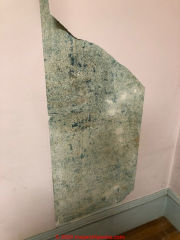
 Thank you got your great and helpful site.
Thank you got your great and helpful site.
I have started taking off wallpaper in two rooms in my house and the plaster underneath does not seem smooth. I don’t think this is just a brown coat, but it’s not the smooth silky surface I would have expected. It is very sandy and would analogize to concrete.
One room is sand colored while the other has a blue tint (is this just glue?) Pictures shown above. [Click to enlarge any image]
My question: Does this need to be top coated before priming and painting, or is it possible to prime as is (once any glue is removed)?
Thanks for your help!
Moderator reply:
At least in your last photo that looks to me like what's commonly referred to as the 2nd or scratch coat.
In a three coat plaster system the scratch coat would have been covered with a hard fine very smooth plaster if the intention was to leave the wall with a plastered and painted surface.
But if the builder intended to install wallpaper from the get-go they may have not put on that final coating.
If the plaster is sound and secure on the wall and if it's free from asphalt or other materials that might bleed through, you could prime and paint it but only if you are happy with the texture that the painted surface will assume. A bit rough.
If there is an unusual contaminant such as asphalt, which I doubt but is possible then you would need to use a primer sealer such as Bin or Enamelac that will not bleed through.
Watch out: Look closely at the surface to be sure that it's not mold contaminated as if that's the case I would not paint over the mold because of the worry of a late growth under the paint and an odor and contamination issue. If we determine that it's moldy we'll discuss your options in that eventuality.
The other reason you want to use a good primer/sealer is the possibility that not all of the wallpaper adhesive has been removed. Old wallpaper adhesive is often water-soluble and may simply have been a mix of flour and water.
Watch out: some old wallpaper that includes green colors contains arsenic and is poisonous. See details
at ARSENIC HAZARDS at BUILDINGS
Reader follow-up:
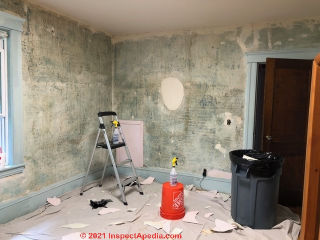 Thanks for your quick response. The information you’ve provided, especially with regards to sealants has been especially helpful. I’ve taken the the wallpaper in one of the rooms and it certainly appears to be plaster with visible horsehair in any of the holes/cracks.
Thanks for your quick response. The information you’ve provided, especially with regards to sealants has been especially helpful. I’ve taken the the wallpaper in one of the rooms and it certainly appears to be plaster with visible horsehair in any of the holes/cracks.
The wall seems to be in great shape with the rough coat being quite smooth to the visible eye (though still rough to the touch). Some of the other rooms in the house have been painted and we thought it had a top coat, but upon closer inspection it seems that these painted rooms may have been straight over the rough coat and look pretty good.
On another note, we are also considering using the rough pourous texture to our advantage and trying a lime wash as an alternative.
Like I said, thanks again for your help, and I’m happy to keep you updated if you think it would be helpful to others.
I wanted to follow-up on our discussion from earlier this year to keep you updated and let you know our results.
It does appear that the walls underneath the wallpaper throughout the house were akin to a brown coat.
However, they were in pretty good shape and relatively smooth, so we decided to use the texture to our advantage to keep the older charm of the house.
 In some of the original pictures that I sent there was a blue texture underneath the wallpaper that I was unsure of.
In some of the original pictures that I sent there was a blue texture underneath the wallpaper that I was unsure of.
As it turns out, there was a similar texture, but different color (yellow, green, and blue) in some of the other rooms - upon further research it seems that this was most likely a distemper paint that was later scraped off.
The process we used was:
(1) remove the wallpaper, which typically took three rounds (bulk removal, remnant paper, glue residue),
(2) repair plaster where necessary using Plaster Magic and drywall patching,
(3) first coat with Zinsser Gardz to seal both any remnant wallpaper glue and the distemper paint,
(4) 2 to 4 coats of Dunn Edwards Everest Flat Paint.
I’ve attached a few before pictures to see the different rooms, as well as a couple after pictures.
Thanks again for running such a helpful site. I hope this might help others too.
... We had one room that had green distemper paint and one room that had one layer of green wallpaper under other layers. However, because the house was built in the 1920s, we were not concerned about arsenic as our understanding was that this was more a concern in the 1800s. Thoughts? Are there other things we should take into consideration?
Moderator reply:
Really beautiful work, Tim, thank you so much.
Did you encounter any wallpaper that was green? If so did you know about the arsenic poisoning risk?
My notes on arsenic in wallpaper are at ARSENIC GREEN in WALLPAPER
Question: cover up cracked plaster or remove plaster and insulate wall cavities
11/5/2014 Gerard Gonzalez said:
I own a old house with plaster lath walls. The walls are starting to show signs of cracks. I also believe that there is limited to no insulation behind these walls. I was told that covering up the old walls with drywall is a better solution, due to the amount of work that comes with demoing plaster walls.
I was wondering if covering the plaster walls with drywall would be a good solution? Also is there anything I can place between the new drywall and old plaster wall that will provide me with better insulation?
Reply:
Gerard,
Laminating a layer of drywall over old plaster is common, is fine, as long as there are not cosmetic issues with burying window and door trim.
You will still have to build out every electrical outlet, wall switch, and light fixture box for proper and safe electrical wiring practices.
Adding a layer of drywall (you could even use lighter 1/4" thick material) over plaster indeed avoids the demolition mess, thus is faster and cheaper.
However that does not address the insulation question. You might consider
1. First, obtain a more accurate assessment of the extent and type of building insulation present - if any.
2. Based on 1., obtain bids on blowing in insulation into walls - from outside or from inside.
3. If insulation is to be blown-in to the building from inside the time to do that is before installing your layer of drywall over the older plaster walls and ceilings.
Indeed instead of blowing in insulation (the most effective approach and one that usually minimizes air leakage) you could
- install a radiant barrier between the new drywall and old plaster (slight benefit)
- install a layer of 1" high-R solid foam board insulation between the old plaster and new drywall - figure a maximum of r-8 per inch which will be less than if you blow insulation into a 3 1/2" deep wall cavity;
this approach will certainly add to the finish work on the interior as in addition to building out the electrical components I cited above, you'll have to build out or remove and replace all trim in the rooms: windows, doors, floor, ceiling.
- install solid foam insulation over furring to give an air space to increase the R-value of the wall - same extra work as the option I just cited.
If you consider the amount of labor in these additional higher R- approaches to wall insulation, the appeal of blowing into the walls increases.
Question: visual clue to determine if an existing expanded metal lath wall system used gypsum-sand plaster or portland cement-sand plaster?
(Feb 19, 2015) Eric Thomson said:
Is there any visual clue to determine if an existing expanded metal lath wall system used gypsum-sand plaster or portland cement-sand plaster? I am trying to determine an equivalent fire rating for the assembly. (wall: 7/8" plaster + 4' steel truss stud + 7/8" plaster) (ceiling: 7/8" plaster on expanded metal lath supported by black iron w/ wire ties)
Reply:
I don't know and will research a bit. A preliminary guess is that cementious materials containing Portland cement would show as more gray and be significantly harder than a gypsum-sand plaster..
Question:
(Mar 27, 2015) David Hunter said:
My home was built in 1927. The interior walls are plaster over wood laths & mesh. The house is damp in the winter and heat is all upstairs. We like the hard plaster walls and don't want to remove them. Is it possible to insulate the interior plaster walls. Can we use drywall over the plaster walls? Will this work? What are the available methods, techniques or materials we can use to reduce dampness and increase insullation. Thank ypu for any advice.
Reply:
Sure you can insulate an existing wall cavity: you can have an insulation contractor blow-in cellulose, chopped fiberglass (maybe), or foam by making appropriate openings from outside or inside the building.
Sometimes it's easier to lift off a few siding boards than to cut and fix and re-paint inside.
Question:
(Sept 3, 2015) Dr manisha jaiprakash said:
Why is plaster of paris put on newly laid floor tiles during ongoing renovation of interiors
Reply:
It is not - though I imagine someone might think that's a way to protect the floors from damage - but it'll be heck to get off.
Reader Questions: Ingredients in plaster: asbestos, horsehair, other fibers. Plaster chemicals used in the UK?
(June 23, 2011) Shoe said:
First of all, thank you for this site.
My questions concern horse hair plaster and/or asbestos plaster. My walls and ceilings are wood lathe and plaster that look very much like the photo above from the Wappinger Falls house and the photo next to it. In a few places, the plaster is damaged, very loose, or missing. I've been operating under the assumption that its horsehair plaster; there are visible threads that look like hair.
Until today, I wasn't aware of the possibility that there could be asbestos, and from my reading, I'm still unsure of whether that's actually likely. As background, the date of record for the house is 1896 (although I believe that a section of the house may be older, and I guess its possible that some or all of the plaster is newer). The house is located in upstate New York.
So here are my questions:
1) Do asbestos fibers look distinctly different than hair?
2) Is it reasonably safe to assume that the presence of horse hair indicates that there probably isn't asbestos? (I've read this claim in forums, but the authors were speculating, not speaking from experience.) What about the powdery asbestos?
3) I read that OSHA guidelines requires that all troweled plasters must be treated as presumed asbestos containing material (PACM). Does that apply to my plaster? What does that mean if I want to hire a contractor to do any work in the house?
Thanks for your help,
Shoe
12/06/2014 aw said:
would lathes in 1930 UK houses that were used for plastering ceiling been treated with any type of chemical?
Reply: asbestos may be mixed into plaster
Shoe:
About the risk of asbestos use in horsehair based plaster, Gman has made an important point: that material was used into the 20th century so some plaster mixes may include asbestos even though asbestos was not in common use in plaster in the earlier 1800's.
I'd respect OSHA's guidelines, and in particular, do not allow a contractor to make a dusty mess in any building if the mess might contain asbestos - not only are there health risks but you're risking a more costly cleanup project than if the material were handled properly in the first place.
What this means in a practical sense is that ANY restoration or renovation work in your home could be much more costly once you notify the contractor that the walls and ceilings may contain asbestos-containing plaster.
Because of that risk of added cost, it would be worth having a few representative plaster samples from your home tested by a certified asbestos testing lab. Individual tests are not expensive, typically costing less than $50. each. If the tests indicate that your particular plaster is asbestos free, you will significantly reduce the cost of renovations and repair work on those surfaces.
- Moderator
(June 27, 2011) Gman said:
Horse hair plaster has be known to contain Asbestos as a bonding matrix, although I'm not entirely sure how common Asbestos use was in the late 1800's. Horse Hair plaster was used right through the 1800's until even the mid - late 1950's.
It was mainly during the period between 1920 and World War 2 that asbestos was the material of choice way up until the late 80's and it was contained in a lot of things - even talcum powder!!! If your house was built from between 1920 - 1950 I would pressume there would be some asbestos within the hair hair plaster as a bonding agent, maybe ranging from about 1% - 10%.
Anything containing asbestos at 1% isn't considered an asbestos material as it is fairly harmless. The fact you live in America might add to the risk as asbestos was more widely used and manafactured in the US more than anywhere else!!
Asbestos will softly crumble in your hands, it will be powdery and you will see tiny needle like hairs (distinctively different from long coarse horse hair)emerging from the substance.
It is definetly correct and safer to treat all troweled plasters with cautuion because 95% of the time they do contain asbestos!! Better being safe than sorry as they say!
You sound very sensible and well done for taking this seriously.
I highly advise you to send a sample off to a contractor or asbestos removal company, they examine and run tests on each sample for about £20 - £30 or in your case $30 - $45 per sample. Its always best to call out a contractor to remove the sample piece for you - in the UK this is usually free of charge, I dont know about the US.
Asbestos removal is very pricey which is why people try to avoid it...bodge it themselves...and then end up dying about 30 years later!
Reply to AW: common constituent ingredients in plaster
AW
Not that I've come across in research - but speaking more generally, water is a chemical as are normal ingredients in plaster. Hydrated lime - gypsum - water. Adapting from Wikipedia and other sources on the ingredients in plaster,
Lime-based plaster such as that found in UK homes is a mixture of calcium hydroxide (lime) and sand (or other inert fillers).
Carbon dioxide in the atmosphere (in other words on exposure to air as the plaster sets and dries) causes the plaster to set by transforming the calcium hydroxide into calcium carbonate (limestone or CaCO3). Incidentally, whitewash is based on the same chemistry but was applied as a thick white paint on building interiors or exteriors.
If you could be more specific about your concern and the reasons for it we may be able to offer some suggestions.
Question: hard gray substrate below plaster
(June 1, 2014) Chris said:
While clearing away the damaged ceiling covering, I discovered a grey hard substrate "below" the white thin plaster-like veneer. The home was built in the 1950s. Inspecting the back of these ceiling boards from the attic, I found brownpaper-backing with numbers printed on (includes 5PH). My guess is that I have a plaster over cement board ceiling, correct?
Reply: scratch coat or rock lath base for finish plaster surfaced walls & ceilings
The gray substrate you see is probably the "scratch coat" on which the finish coat was applied. Or plaster may have been applied over cement board as you infer.
Certainly I have read of plaster application over cement board or "asbestos cement board" or "millboard" in several applications, particularly where fireproofing was important such as in boiler rooms.
But plaster was more widely applied over rock lath or gypsum board.
See GYPSUM BOARD PLASTER LATH SYSTEMS
(June 1, 2014) Chris said:
Thanks, Moderator; I'm pretty sure that a 1/16" plaster application was made to a cement board with brownpaper-backing--the white plaster-like material came away cleanly in shards using a putty knife.
The consistent thickness of the plaster application makes me wonder if the boards came with it factory-applied back in those days (presuming the ceilings are original, which I don't know).
I plan to apply a bleach-water mixture to the discolored cement area where the water came through, use a mortar caulk/sealant in the cement board crack, and use joint compound to replace the scraped away plaster.
Reply:
Chris, Yes it sounds as if you're looking at a version of rock lath - a plaster board that was used as a base for a finish coat of plaster applied by hand.
...
Continue reading at PLASTER ASBESTOS CONTENT or select a topic from the closely-related articles below, or see the complete ARTICLE INDEX.
Or see these
Recommended Articles
- DRYWALL, FIBERBOARD, PLASTER INTERIORS - home
- DRYWALL & GYPSUM BOARD COMPOSITION & HISTORY
- PLASTER ASBESTOS CONTENT
- PLASTER BULGES & PILLOWS
- PLASTER DUST EXPOSURE HEALTH HAZARDS
- PLASTER INGREDIENTS, MIX, PROPERTIES
- PLASTER LATH, METAL
- PLASTER, LOOSE FALL HAZARDS
- PLASTER TYPES & METHODS in BUILDINGS
- PLASTER VENEER Best Practices
- PLASTERBOARD / DRYWALL EXPANSION COEFFICIENTS
- STUCCO WALL METHODS & INSTALLATION - plaster type surfaces used on building exteriors
Suggested citation for this web page
PLASTER INGREDIENTS, MIX, PROPERTIES at InspectApedia.com - online encyclopedia of building & environmental inspection, testing, diagnosis, repair, & problem prevention advice.
Or see this
INDEX to RELATED ARTICLES: ARTICLE INDEX to BUILDING INTERIORS
Or use the SEARCH BOX found below to Ask a Question or Search InspectApedia
Ask a Question or Search InspectApedia
Try the search box just below, or if you prefer, post a question or comment in the Comments box below and we will respond promptly.
Search the InspectApedia website
Note: appearance of your Comment below may be delayed: if your comment contains an image, photograph, web link, or text that looks to the software as if it might be a web link, your posting will appear after it has been approved by a moderator. Apologies for the delay.
Only one image can be added per comment but you can post as many comments, and therefore images, as you like.
You will not receive a notification when a response to your question has been posted.
Please bookmark this page to make it easy for you to check back for our response.
IF above you see "Comment Form is loading comments..." then COMMENT BOX - countable.ca / bawkbox.com IS NOT WORKING.
In any case you are welcome to send an email directly to us at InspectApedia.com at editor@inspectApedia.com
We'll reply to you directly. Please help us help you by noting, in your email, the URL of the InspectApedia page where you wanted to comment.
Citations & References
In addition to any citations in the article above, a full list is available on request.
- Roger Hankey is principal of Hankey and Brown Inspections, Winter Park, CO. Mr. Hankey is a past chairman of the ASHI Standards Committee and served in other ASHI chapter and national leadership roles. Mr. Hankey is a National Radon Proficiency Program certified measurement professional and a Level II infrared thermographer. Contact Roger Hankey at: 970-393-6604 - rogerhankey47@gmail.com . Website: www.HankeyandBrown.com Mr. Hankey is a frequent contributor to InspectAPedia.com.
- Asbestos products and their history and use in various building materials such as asphalt and vinyl flooring includes discussion which draws on ASBESTOS, ITS INDUSTRIAL APPLICATIONS, ROSATO 1959, D.V. Rosato, engineering consultant, Newton, MA, Reinhold Publishing, 1959 Library of Congress Catalog Card No.: 59-12535 (out of print).
- ASHI, American Society of Home Inspectors,® Inc., 932 Lee Street, Suite 101, Des Plaines, Illinois, 60016. The American Society of Home Inspectors is the first and leading national association of home inspectors in the U.S. Website: www.ashi.org
- ASTM C 842
- ASTM C 841 Metal Lath or gypsum lath installation
- Plastering, PM 5, Product & Systems Technology, US Gypsum, May 1998, web search 10.5.2010, original source: http://www.usg.com/rc/technical-articles/plaster/
plastering-technical-guide-veneer-plaster-joint-reinforcement-systems-en-PM5.pdf
United States Gypsum Company, 125 South Franklin ST., PO Box 806278, Chicago, IL 60680-4124,
Paraphrasing from this document: USG uses the term shadowing in this document in describing the visual effect over gypsum board joints caused by the lower moisture absorption rate (take-up) and lower capacity than gypsum base face paper. Shadowing at joints occurs where veneer plaster is applied over tape joints, requiring a second coat to completely hide the tape, providing a visually uniform surface. USG Advises: "This [second] cover coat must be allowed to harden and dry before plaster application is started. - Gypsum Construction Handbook [purchase at Amazon.com] H17, Technical Folder SA920 and PM2, PM3 and PM4, United States Gypsum Company, 125 South Franklin ST., PO Box 806278, Chicago, IL 60680-4124,
- Plastering Skills, F. Van Den Branden, Thomas L. Hartsell, Amer Technical Pub (July 1, 1985), ISBN-10: 0826906575, ISBN-13: 978-0826906571 [purchase at Amazon.com]
- Gypsum Construction Guide, National Gypsum Corporation
- Metal Lath Specifications, Specification for metal lath and accessories, Lath and Plaster from Amico, a lath and plaster accessory producer.
- Lath & Plaster Systems, 092300/NGC, National Gypsum Lath and Plaster Systems, National Gypsum Corporation, 800-628-4662 describing National Gypsum's Kal-Kore brand plaster base
- Gypsum Construction Guide, National Gypsum Corporation, 2001 Rexford Road, Charlotte, North Carolina 28211, Tel: 704-365-7300, Email: ng@nationalgypsum.com, Website: http://www.nationalgypsum.com
- Metal Lath Specifications, Specification for metal lath and accessories, Lath and Plaster from Amico, 3245 Fayette Ave. P.O. Box 3928, Birmingham, AL 35208, (205) 787-2611, (800) 366-2642 and in Canada: 1080 Corporate Drive, Burlington, Ontario L7L 5R6, Canada, (905) 335-4474, (800) 663-4474. Amico is the largest metal lath producer in North America. Website: http://amico-lath.com/
- Our recommended books about building & mechanical systems design, inspection, problem diagnosis, and repair, and about indoor environment and IAQ testing, diagnosis, and cleanup are at the InspectAPedia Bookstore. Also see our Book Reviews - InspectAPedia.
- In addition to citations & references found in this article, see the research citations given at the end of the related articles found at our suggested
CONTINUE READING or RECOMMENDED ARTICLES.
- Carson, Dunlop & Associates Ltd., 120 Carlton Street Suite 407, Toronto ON M5A 4K2. Tel: (416) 964-9415 1-800-268-7070 Email: info@carsondunlop.com. Alan Carson is a past president of ASHI, the American Society of Home Inspectors.
Thanks to Alan Carson and Bob Dunlop, for permission for InspectAPedia to use text excerpts from The HOME REFERENCE BOOK - the Encyclopedia of Homes and to use illustrations from The ILLUSTRATED HOME .
Carson Dunlop Associates provides extensive home inspection education and report writing material. In gratitude we provide links to tsome Carson Dunlop Associates products and services.


